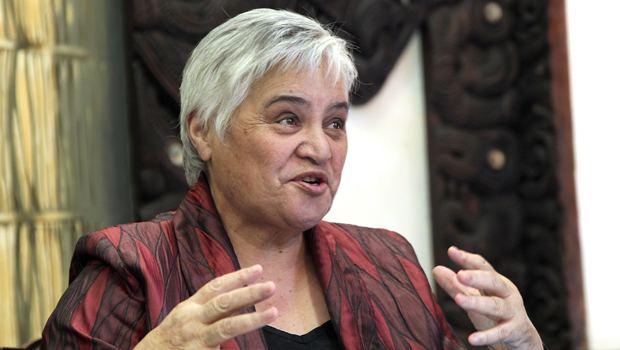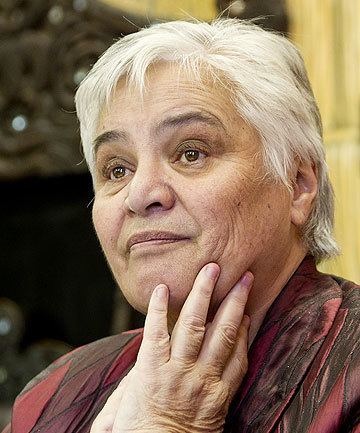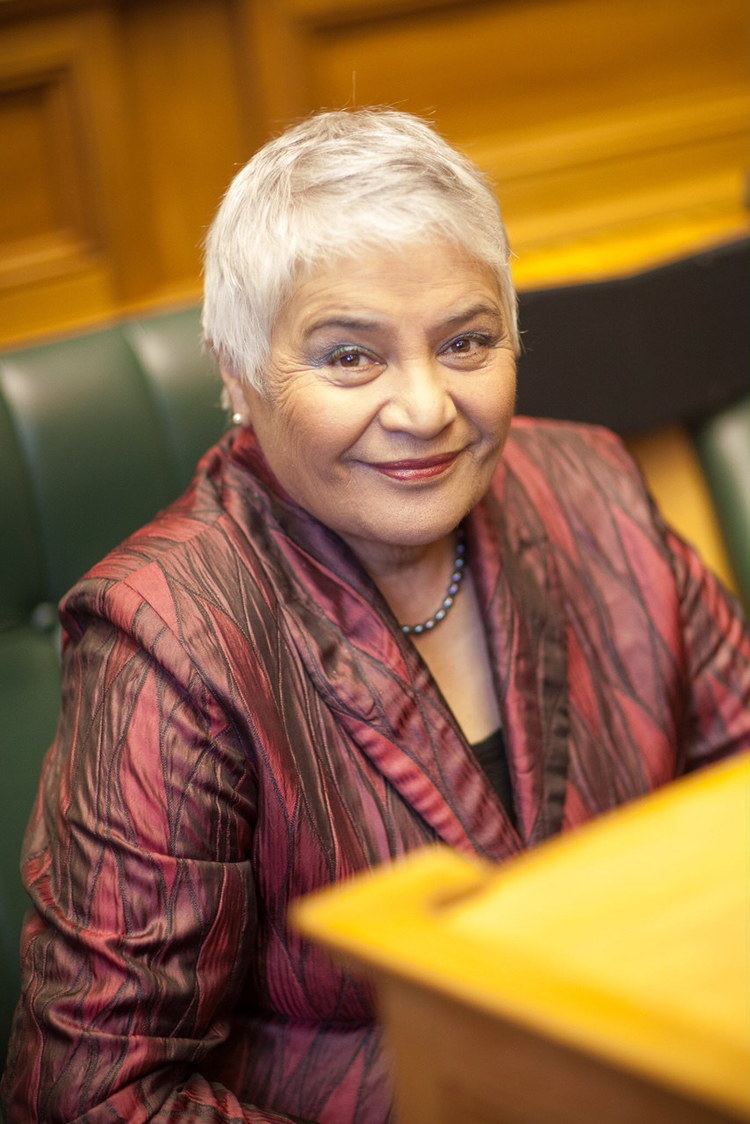Spouse George Turia Resigned 2002 | Prime Minister John Key Name Tariana Turia Role New Zealand Politician | |
 | ||
Similar People Profiles | ||
Organizations founded Maori Party | ||
Dame Tariana Turia’s endorsement of Helen Clark at odds with Māori Party
Dame Tariana Turia (born 8 April 1944) is a New Zealand politician. She gained considerable prominence during the foreshore and seabed controversy, and eventually broke with her party as a result. She resigned from parliament, and successfully contested a by-election in her former electorate as a candidate of the newly formed Māori Party. She retired from Parliament in 2014.
Contents
- Dame Tariana Turias endorsement of Helen Clark at odds with Mori Party
- Valedictory statement tariana turia 24th july 2014 part 5
- Early work
- Member of Parliament
- Foreshore and seabed legislation
- By election
- 2005 general election
- 2008 general election and ministerial posts
- References
Valedictory statement tariana turia 24th july 2014 part 5
Early work

Turia was born in 1944 to an American (probably Native American) father and Māori mother. Her Māori roots are Whanganui, Ngāti Apa, Ngā Rauru, and Tūwharetoa iwi.

She is married to George Turia. They have 4 children, 2 whāngaia, and 28 grandchildren, and great grandchildren.
Before entering politics, she had considerable involvement with a number of Māori organisations, working with Te Puni Kōkiri (the Ministry of Māori Development) and a number of Māori health providers. She also had associations with the Te Kura Kaupapa and kohanga reo movements.
^a Child adopted though Māori customary practice of adoption within the extended family, or WhānauMember of Parliament
Turia entered the New Zealand Parliament in the 1996 election as a list MP for the Labour Party, ranking 20th on the party list. In the 1999 election, she remained a list MP, but ranked sixteenth. In the 2002 election, however, she contested the Te Tai Hauauru Māori electorate, and opted not to place herself on the party list at all. Te Tai Hauauru (roughly, the Māori voters of the west of the North Island) returned her as their member of parliament.
Although never a member of Cabinet, Turia has held a number of non-Cabinet ministerial roles. From Labour's electoral victory in 1999, she served as Associate Minister of Māori Affairs, Associate Minister of Social Services and Employment, Associate Minister of Health, and Associate Minister of Housing. In 2002, she also became Associate Minister of Corrections. After the formation of the Labour-Progressive coalition in 2002, she dropped the Corrections role and gained full ministerial rank as Minister for the Community and Voluntary Sector.
Foreshore and seabed legislation
When debate about ownership of New Zealand's foreshore and seabed broke out in 2003, and the Labour Party proposed vesting ownership in the state, Turia voiced dissatisfaction. Along with many of her supporters in Te Tai Hauauru, she claimed that Labour's proposal amounted to an outright confiscation of Māori land. When it became publicly known that Turia might vote against Labour's bill in parliament, tensions between Turia and the Labour Party's leadership increased. The hierarchy strongly implied that if Turia did not support Labour policy, she could not retain her ministerial roles.
By-election
On 30 April 2004, after a considerable period of confusion about Turia's intentions, she announced that she would resign from parliament on 17 May. This precipitated a by-election being called in Te Tai Hauauru, which Turia contested as a member of the new Māori Party that formed around her. On the same day that Turia announced her resignation, Prime Minister Helen Clark sacked her from her ministerial posts.
Her supporters see Turia as having bravely defied her party in order to stand up for her principles. Her critics, however, portray her as dangerous and racist, notably for her support for race based policies which favour Maori over other New Zealanders. The Labour Party has criticised Turia for putting the foreshore and seabed issue before the party's wider policies for Māori development, and says that she has unreasonably focused on a single issue. Helen Clark said that Turia had shown "an astonishing lack of perspective". Turia described the Te Tai Hauauru by-election of 10 July 2004 as a chance to test her mandate, and to ensure that she had the support of her voters, but doubts remained about the significance of the by-election, since none of the major parties put forward candidates. Labour called the event "a waste of time and money".
Turia received 92.74% of the vote in the by-election, and resumed her seat in Parliament on 27 July 2004.
2005 general election
On 17 September 2005, the Māori Party contested the general election with electoral candidates in all seven of the Māori seats. Turia was re-elected in Te Tai Hauauru and that night three more Māori Party candidates won parliamentary seats, Pita Sharples (co-leader) in Tamaki Makaurau, Hone Harawira in Te Tai Tokerau and Te Ururoa Flavell in Waiariki. The winning of the four seats resulted in celebration for their supporters who anticipated seeing an independent, Māori voice in parliament. However, the Māori Party share of the party vote across the country was 2.1 percent, placing them sixth out of the eight parties in parliament by party vote. This was attributed to voters in the Māori electorates mainly giving their party vote to the incumbent Labour government.
2008 general election and ministerial posts
Support for the Māori Party in the 2008 general election increased with the party gaining an additional seat. National won most seats overall, to form a minority government with support from the Māori Party as well as ACT New Zealand and United Future. In return for Māori Party support in confidence and supply, John Key agreed to not abolish the Māori seats without the consent of Māori. It was also agreed to review the Foreshore and Seabed Act 2004 and to consider Māori representation in a wider constitutional review which began in 2010. Turia and co-leader Sharples were both made Ministers, although like other support party members both remained outside Cabinet. Turia was given the portfolios of Minister for the Community and Voluntary Sector, Associate Minister of Health and Associate Minister for Social Development and Employment, while Sharples was made Minister of Māori Affairs. When Paula Bennett stepped down as Minister for Disability Issues on 30 June 2009, Key appointed Turia the new minister. In 2010, the National and Māori Parties announced Whānau Ora, a taskforce designed to streamline social service resources. Turia was announced Minister responsible for the implementing of the scheme.
In the (49th New Zealand Parliament, 2008–2011) New Zealand parliamentary vote on the composition of the Abortion Supervisory Committee (7 April 2011), anti-abortion Maori Party Turia moved that an anti-abortion Pacific Island doctor, Dr Ate Moala, be appointed to the ASC. The resultant vote was 70–30 against Ms Turia's motion, with twenty absences or abstentions. Altogether, twenty six National Party MPs and four Maori Party MPs voted for the addition of Dr Moala, while all Labour and ACT MPs and several National Party MPs as well as Independents Chris Carter and Hone Harawira, and United Future MP Peter Dunne voted against the motion, which was lost
Turia confirmed in November 2013 that she would retire at the 2014 election.
